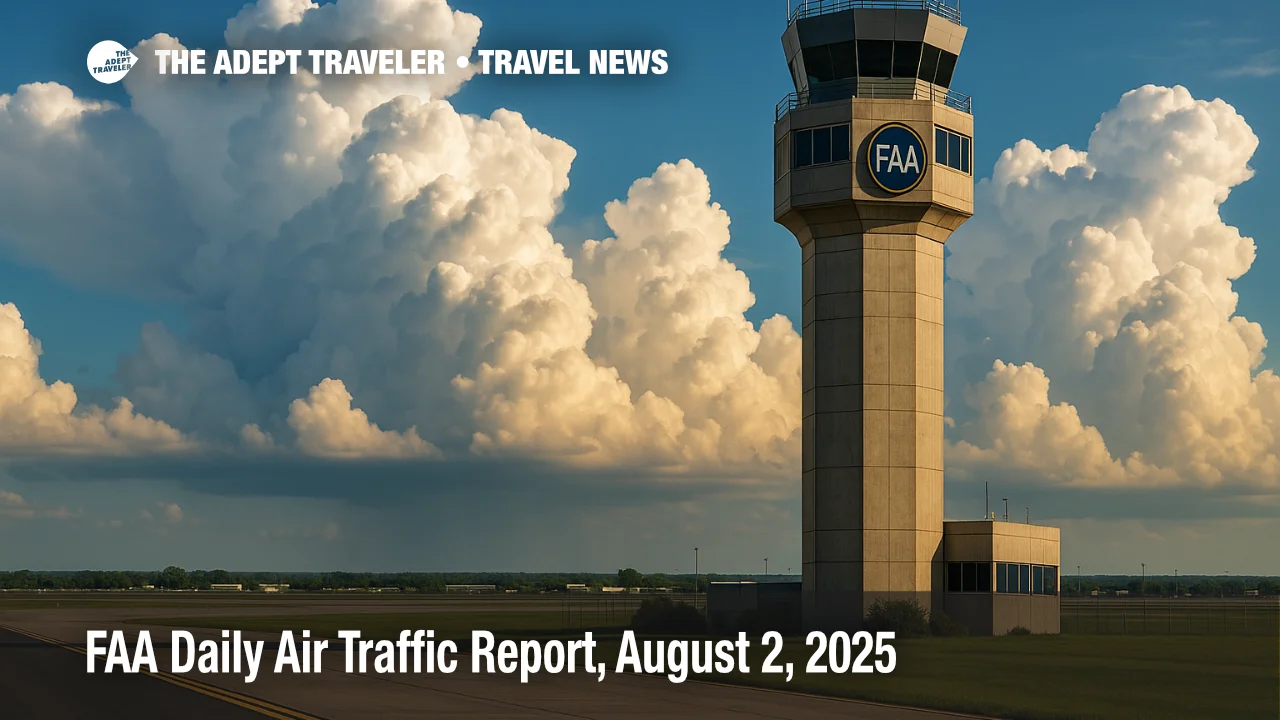FAA Daily Air Traffic Report, August 2, 2025: Storm Delays

Travelers might need extra patience today. The Federal Aviation Administration's (FAA) operations plan flags a volatile weather mix-coast-to-coast thunderstorms, wildfire haze, and stubborn low clouds-plus a critical staffing pinch around Philadelphia. As part of The Adept Traveler's daily FAA coverage, we break down the bulletin so you know which airports, routes, and launch windows could snarl your itinerary before wheels-up. Always check with your airline and monitor the FAA's live tools for real-time updates. Two spaces after every period.
Key Points
- Why it matters: Thunderstorms and staffing triggers could push ground stops from Newark to Denver.
- Travel impact: Expect rolling delays after 11 a.m. ET at EWR, SFO, DEN, ATL, and other hubs.
- What's next: FAA planning webinar at 11:15 Z will refine afternoon initiatives.
- Possible rocket-launch reroutes along Florida's Space Coast.
- Ongoing runway work continues at Dallas Love Field and Newark.
Snapshot
Convective storms stretch from the Gulf of Mexico to the northern plains, while smoke and haze linger over Denver and Minneapolis. West-coast marine layers threaten low-ceiling programs at San Francisco, San Diego, and Seattle. The FAA's Air Traffic Control System Command Center warns that ground stops or delay programs could activate at Newark after 11 a.m., Denver after noon, Tampa after 3 p.m., and Atlanta after 6 p.m. Philadelphia's Area C remains on a staffing trigger until 5 p.m., increasing the odds of wider East-Coast cascades. Travelers should build in extra connection time and monitor gate changes.
Background
The FAA publishes a daily air traffic bulletin combining meteorology, equipment outages, special-use airspace, and staffing constraints to forecast national system pressures. Airlines and airports use the report to time ground delay programs, reroute traffic, and coordinate with the FAA's Command Center in Warrenton, Virginia. The Adept Traveler shares these bulletins every morning so U.S. travelers can anticipate bottlenecks before arriving at the airport. Yesterday's update focused on widespread thunderstorms and low clouds; today's bulletin adds wildfire smoke, a potential SpaceX launch backup window, and a localized staffing shortfall around Philadelphia.
Latest Developments
FAA Daily Air Traffic Report: Thunderstorms and Staffing Alerts
Thunderstorms dominate today's risk map. The Atlantic "Y" routes through Jacksonville Center face convective cells that could force oceanic detours, while Gulf storms near Houston threaten Houston Bush (IAH) and Hobby (HOU) departures. Northern-plains storms add a layer of complexity for trans-con flights. Low ceilings on the West Coast may trigger San Francisco ground delays after 3:30 p.m. local. Meanwhile, smoke and haze impair visibility over the Denver terminal area, raising the odds of flow controls after noon. Philadelphia's Area C staffing trigger is active until 5 p.m.; the FAA warns a ground stop could ripple through the Northeast corridor. Runway closures at Newark (11/29) and Dallas Love Field (13L/31R) further squeeze capacity.
Analysis
Summer weather volatility, compounded by construction and crew shortages, illustrates how interconnected the National Airspace System has become. A single staffing trigger in Philadelphia can force miles-in-trail spacing that slows departures from Atlanta and arrivals into Boston. Thunderstorms over the Gulf impede Houston traffic but also pinch westbound departures from Florida, where afternoon storms often flare. Today's advisory lists eight major hubs with potential ground stops-double the average for early August. Flight-planning software will seek alternate routes, but en-route thunderstorm clusters across ZNY, ZDC, ZJX, and ZMA centers limit usable airways. Add runway projects at Newark and Dallas Love Field, and the margin for delay-free operations shrinks further. Travelers holding tight connections should consider rebooking or requesting protective itineraries. Airlines typically waive change fees when the FAA issues prolonged ground programs, but availability diminishes quickly once delays stack up.
Final Thoughts
Today's FAA daily air traffic report underscores how swiftly weather, construction, and staffing intersect to disrupt schedules. Keep the bulletin-and The Adept Traveler's updates-handy, build flexibility into your plans, and check airline apps frequently. Staying proactive is the best defense against cascading flight delays flagged in the FAA daily air traffic report.
